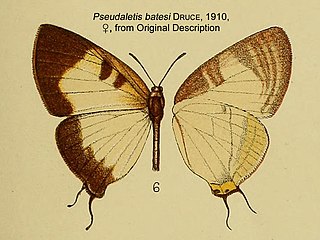
Dollman's tree mouse is a poorly understood climbing mouse from central Africa. It is unique enough that it has been placed in a genus of its own, Prionomys, since its discovery in 1910.

Bates's pygmy antelope, also known as the dwarf antelope, pygmy antelope or Bates' dwarf antelope, is a very small antelope living in the moist forest and brush of Central and West Africa. It is in the same genus as the suni.

The Congo serpent eagle is a species of bird of prey in the family Accipitridae. It is the only member of the monotypic genus Dryotriorchis, although it was formerly placed in Circaetus. This species is distributed across the African tropical rainforest, including upper and lower Guinean forests. This serpent eagle specializes in hunting in these forests’ dark understories. It has two subspecies, the nominate subspecies Dryotriorchis spectabilis spectabilis and Dryotriorchis spectabilis batesi. Though monotypic, it appears to be very closely related to Circaetus. This hawk is a medium-sized bird with distinctive short, rounded wings and a long, rounded tail. It is varying shades of brown on its back and has a slight crest. Its breast is white with variable amounts of a rufous wash and, in the nominate subspecies, is covered in round, blackish spots. The subspecies D. s. batesi only has these dots on its flanks. The Congo serpent eagle closely resembles Cassin's hawk-eagle, and some ornithologists believe that this likeness is a rare example of avian mimicry. It is a very vocal raptor, and often is one of the most heard species in its habitat.
Bates's swift is a species of small swift in the family Apodidae which is found in western Africa.

Bates's nightjar or the forest nightjar, is a bird species of the family Caprimulgidae, found in the rainforests of western Sub-Saharan Africa.

Bates's sunbird is a species of sunbird in the family Nectariniidae which occurs in Western African forests and Central African rainforests, and locally in other types of forest in Central Africa.

Bates's weaver is a species of bird in the family Ploceidae. It is endemic to Cameroon, and is often regarded as inexplicably rare across its distribution.

Bates's paradise flycatcher is a passerine bird belonging to the monarch-flycatcher family, Monarchidae. The sexes are similar in appearance with the upper parts being rufous and the head and underparts being bluish-grey. It is native to central Africa where it is found in the understorey of forests.

Spilosoma batesi is a moth of the family Erebidae. It was described by Walter Rothschild in 1910. It is found in Nigeria, Cameroon, Congo and Zaire.

Pseudaletis batesi, the black fantasy, is a butterfly in the family Lycaenidae. The species was first described by Hamilton Herbert Druce in 1910. It is found in Cameroon, the Republic of the Congo, the Central African Republic and the Democratic Republic of the Congo. The habitat consists of forests.

Hemilophini is a tribe of longhorn beetles of the subfamily Lamiinae.
Lycidola is a genus of longhorn beetles of the subfamily Lamiinae, containing the following species:
Eunidia batesi is a species of beetle in the family Cerambycidae. It was described by Olliff in 1889.
Lycidola beltii is a species of beetle in the family Cerambycidae. It was described by Henry Walter Bates in 1872. It is known from Nicaragua and Honduras.
Lycidola expansa is a species of beetle in the family Cerambycidae. It was described by Henry Walter Bates in 1881. It is known from Costa Rica, Colombia, and Panama.
Lycidola felix is a species of beetle in the family Cerambycidae. It was described by Waterhouse in 1880. It is known from Ecuador.
Lycidola flavofasciata is a species of beetle in the family Cerambycidae. It was described by Waterhouse in 1880. It is known from Bolivia, Ecuador and French Guiana.
Lycidola palliata is a species of beetle in the family Cerambycidae. It was described by Johann Christoph Friedrich Klug in 1825. It is known from Brazil.
Lycidola popeba is a species of beetle in the family Cerambycidae. It was described by Galileo and Martins in 2006.
Lycidola simulatrix is a species of beetle in the family Cerambycidae. It was described by Henry Walter Bates in 1866. It is known from French Guiana and Brazil.








